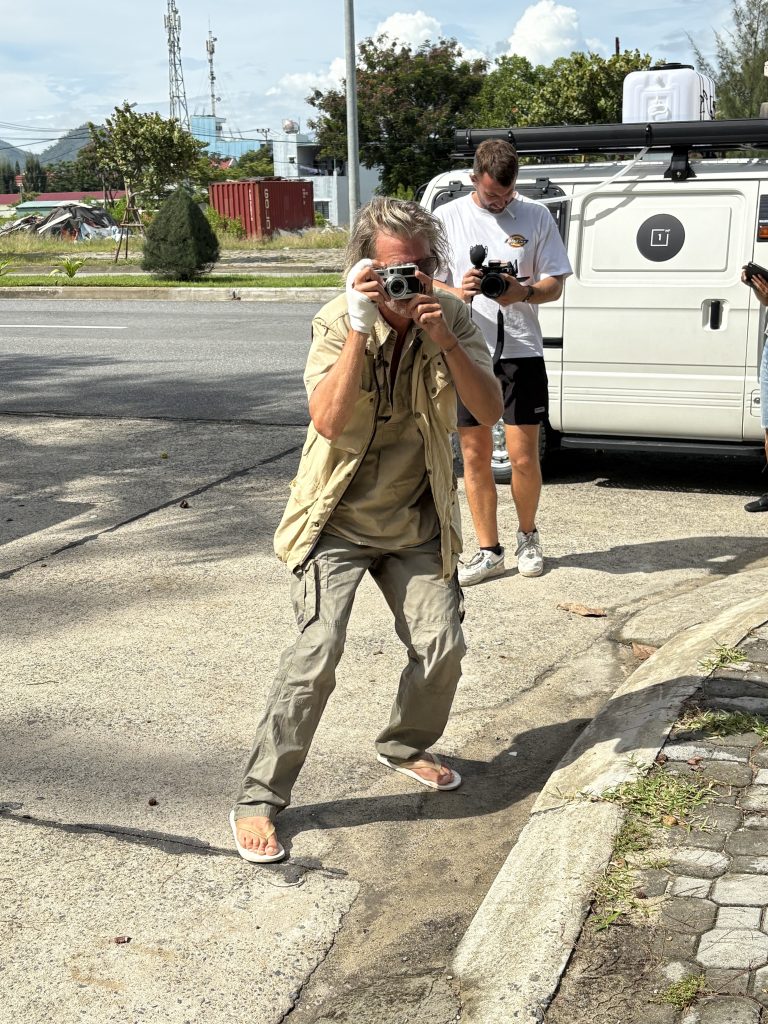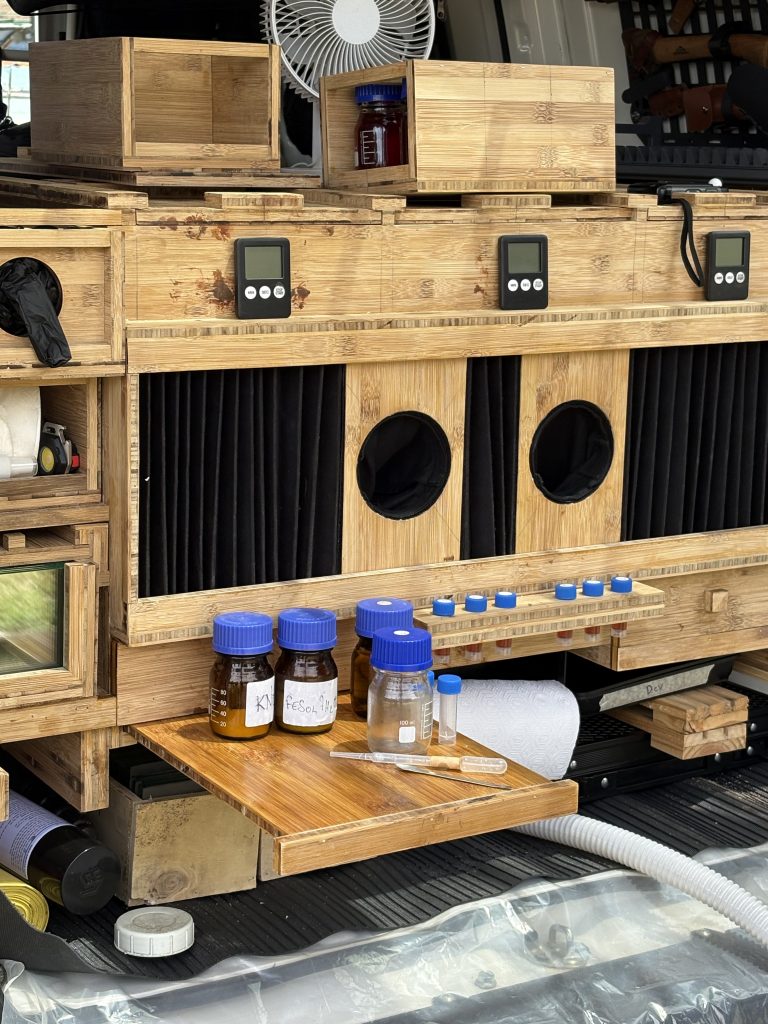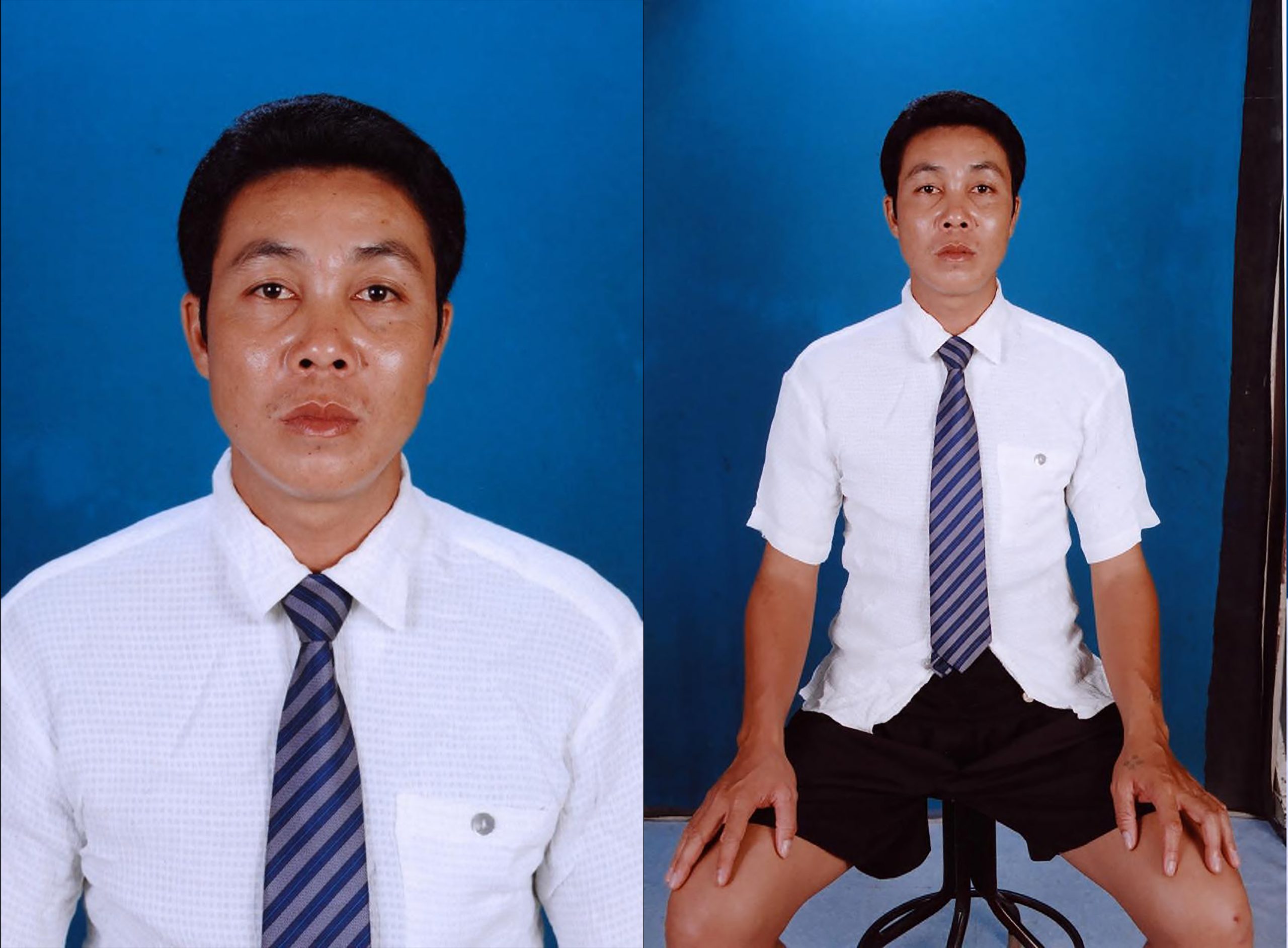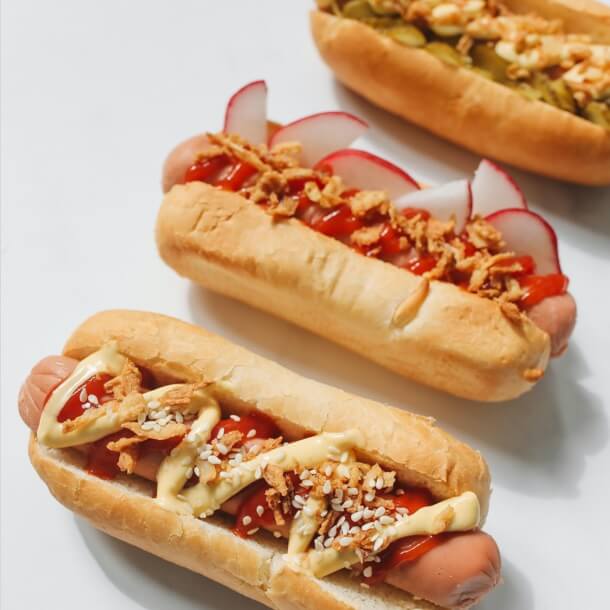A few days after the autumnal equinox, a reconnaissance mission set out from the coastal wetlands of central Viet Nam, hitting the highway somewhere between Hoi An and Danang. This ragged expeditionary force left with a mix of intestinal fortitude and slight trepidation. A band of gypsies, gourmands and fotograf groupies making their first foray from the safe house location of Một Mét Studio. It was time to test the mobile wet plate studio beyond proof of concept. They pushed forth slowly, resolute and focused through the smoky haze of post-rice harvest burn and into unknown weather at the onset of the wet season. What could go wrong, it seemed, was part of the plan to push the limits of this novel approach – literally taking the show on the road. Hitching a ride on their wagon train as it weaved its way tentatively through the coastal sands, the French Institute in Vietnam compiled an eyewitness account of what transpired.

When the circus rolls into town, people tend to gather round. Only the curious come first, bravely putting any initial inhibitions aside. Who are these strangers? What are they doing in there? As the mobile laboratory cranks into gear, the alchemy on show creates a gravity all of its own, drawing in the audience of bemused locals to watch this arcane mix of scientific precision and experimental art.
Photographer Boris Zuliani sniffs the air, cigarette drooping from his lips as he snaps on a pair of surgical gloves. His eyes are active, taking in the entirety of the scene around him as he plans the first of many frames to capture the morning light. He must work fast, for as the day heats up, so too the elements of his volatile arsenal of combustible compounds. Ether, nitro-cellulose (aka guncotton) and methanol – vital ingredients for his chosen wet-plate collodion photographic technique. Only a few missteps from explosive consequences. Then there is the silver nitrate, which together with lithium and iodide brings the crucial light sensitivity to the whole combination immediately prior to exposure. Zuliani pushes his vintage-framed spectacles back over the bridge of his nose, working with practiced hands as he goes through the sequence. His precision sets up a plethora of possibilities for the final artistic outcome.
In the back of a converted Suzuki van, he has installed a bespoke laboratory handmade from sheets of compressed bamboo. Storage units for the 10x10cm glass plates, drawers and platforms for stabilizing beakers and pipettes, and gloved holes for his blackened hands to work under the infra-red light in the mini darkroom of this bamboo box. Next to the emergency rack where a squared-off machete and tomahawk remain secured, Zuliani is surrounded by well-hung cannisters of his essential liquids – their temperatures newly stabilized by a 12-pack of frozen water bottles. This jerry-rigged solution helps to keep everything within that crucial range of 20-25 degrees Celsius. But it remains a delicate balance to prevent the ingredients from getting too hot or too cold, particularly the silver nitrate, and avoid bringing a cloudy result to the plate. This discovery, which as befitting such revelation, arrived on the third day of the road trip, was all about getting the ice sitting as close to the silver nitrate tank as possible, thus extending the outdoor shoot to 2-3hrs per session.
On ground, Zuliani must work fast. Five minutes marks the total envelope of temporal action to set up the camera, prepare plates, shoot, develop, and fix each image. Some crucial assistance from Thomas Dessein, himself a photographer, makes this oppressive timeframe achievable with his patient moves and mindful mise-en-place. Once Zuliani commits to a frame, he explains, the preparation must be efficient and focused – any diversion means he must adapt quickly or move his sights to another target.
“Everything is so one-off, only sometimes you can make two shots of the same frame composition. Like a sniper you must be fast and deadly accurate with each shot,” he says.
In the coastal villages, fishermen are usually busy either with their boats or their nets, while beachside cafes remain sparsely populated as the day begins. At the dock, a small crew arrives with a huge pot of freshly made duck soup, rough cut noodles and bone broth. Harbourside workers flock hungrily to the food after the dawn shift filling boats with ice before the next voyage into the East Sea. When the ships return, the same labor force unloads the latest catch from boats stuck at sea over several nights. And so the fishing cycle continues, searching for those elusive shoals to bring back sustenance and bolster livelihoods for the coastal communities from north to south of the country.
Racks of lights decorate the upper rigging of the larger fishing boats, ready to illuminate the ocean and attract squid up from the depths. Ropes form tightly coiled patterns on the deck of vessels coloured blue, red, white, yellow, together with the rust of anchors weighing heavy. Almond-shaped eyes glisten with salty tears on the prow, forever alert to forewarn the mariners of any danger lurking in the water.
Zuliani scouts the locale with a practiced eye, taking in various objects, line and colour – imagining how his composition will look in the gray-scale intensity of a wet-plate ambrotype. To the keen observer, he is clearly the ringmaster of this troupe. But to the locals of whichever stop he makes, he may appear more like a lone matador, daring his audience to engage with what he pulls forth from his cabinet of curiosities.

He waves a red-lined black cape with a flourish, walking from the van with a vintage Technica large format camera fixed to a tripod, places it on the ground and ducks under the muleta for his final check through the viewfinder. The glass plate, now covered with that pre-mixed collodion, is then locked and loaded into the camera. A standard light meter measures the lux intensity, but it is only through experience that he can gauge how the chemistry will respond on the day. With a keen eye on the weather, he reads the sky as to what he may need to adjust within his mise-en-scene to capture a sharp contrast, balancing perspective with detail.
“The collodion reacts to only the blue part of the RGB spectrum – so the variability in UV light can really affect the potential of the shot,” Zuliani explains. “The light meter reading helps but does not give you any insight on the quantity of UV. To get the best result with the collodion, I must set the aperture sometimes five stops different from the light meter reading depending on the UV. But I have nothing to calculate this with except my eyes.”
It is only by experience that Zuliani can even get close to getting it correct. Sometimes he must shoot and recalibrate, through trial and error finally being able to catch the mood and form of his composition. Even if he comes back to the Technica to load a second shot, so many changes may have happened in those ensuing minutes – light, shadow, or just the inexorable passage of time: the subject may have simply moved or wandered off. Each frame thus becomes a unique single-shot coalescence of art and science, mixing chance and design to reinvigorate this 19th century photographic technique. For Zuliani, working to defy the digitalization of the photographic arts with collodion’s unpredictability forms the essence of his continuing quest for elusive perfection.
He can push his darkroom materials to new limits only by way of hands-on knowledge gleaned from his long apprenticeship in the fashion industry, including time on staff at the late lamented Studio des Plantes. He still approaches his wet plate shots the same way – engaging with people, situations, light, frame to conjure the best from what is available. He has retained that innate professionalism without thinking about the ‘product’ – his own standards will determine whether the individual plate meets his deliberately exacting personal aesthetic.
“When I shoot, I still have the mindset of doing an editorial assignment for a magazine. But there is a difference: in the studio everything is under control – light, temperature, movement – but outside is a completely different story. On the road I feel more like a film producer, thinking fast to get the frame in my head and move all the pieces into position before the scene changes – out there, nothing is predictable.”
He is keenly aware that the process takes time to master: “I must be careful not to be nostalgic or emotional about what I shoot – I know deep down I need to shoot many more photos to get to where I will be totally happy. It’s an evolutionary step every time.”
For this field operation, limited time necessitates deploying guerilla tactics: arrive, set up, scout and confirm subject, talk to people, prepare glass, shoot photo, develop, eat, drink. Then move on without a fuss, leaving nothing but tyre tracks and a few drops of developing fluid. Lessons learned will bolster plans for what can come next, mistakes made will refine the method, every day brings chance meetings which open up new potential. Through the looking glass, Zuliani smiles in reflection of what trial and error can bring. Each discovery catalyzes a new tangent to his journey, like slight movements adding something special to the frame.
“I really feel this mobile studio approach has set up opportunities for going deeper, I want to discover new locations and stay there for several days. Only then can you develop relationships with people, different places and find new subject matter,” he explains.

“When I have time to make mistakes I can also learn fast, so if we have the luxury to repeat until we get it right, that is really what I need to refine my approach. I have to understand what is happening with all these variables in a particular setting and adapt every day. I feel this is my ongoing apprentissage to the wet plate technique.”
Zuliani remains obsessed with what he calls ‘light painting’, pushing the envelope of photosensitive materials to create unique textures and tones with his photography. In 2017, he moved south from Hanoi to set up a makeshift studio in a garage on the dusty outskirts of Hoi An. There he began experimenting with the wet plate collodion technique (including the Wanted! series of workers’ portraits in collaboration with local gallery and art residency Kyara Arthouse – a selection of which is also part of Zuliani’s show at Photo Hanoi ’25 – while working with his wife to design and build the edifice which has become Một Mét Studio.
Amid the solid state steel girders and brickwork, Mot Met Studio’s floor-to-ceiling glass windows welcome natural light from the south-east, looking onto lotus-strewn wetlands where buffaloes wallow. The building itself, aside from being his home, has been custom-designed to function as a camera obscura. The 13m x 8m space includes an imposing 1210mm lens, used for cartography in its former life, housed in a black steel sliding door. Zuliani can shoot portraits of unforgiving detail onto glass plate formats of up to 2m x 2m, giving him the rare opportunity to work with a 1:1 ratio.
Zuliani arrived in Viet Nam in 2007, so fired up by an encounter with the giant polaroid camera set up in Vienna by The Impossible Project that he brought 5000 boxes of unexposed Polaroid film in his luggage. While working for fashion assignments in the bustling metropoli of Hanoi and Ho Chi Minh City, he continued to pursue his own artistic projects on the side with all that Polaroid film – including a series of moody portraits of lovers on the Long Bien bridge which spans the Red River on Hanoi’s eastern fringe.
Taking Mot Met mobile has pushed him further outside the perimeter, allowing him to continue a series which he started nearly two decades ago documenting the littoral regions bordering the East Sea – a project he feels was unfinished until now.
“I like the coast, I like the sea, I like fishing, I like fishermen. When I can, I sometimes fish with them – they have a tough job, but I feel comfortable with them,” he says of his ongoing fascination.
There is an absence of social commentary in his work, which he admits is purely aesthetic in its motivation. But he has an affinity with the coastline, and with the fishermen. Zuliani is curious to understand their lifestyle and to document it honestly.
He found the narrative thread for the Photo Hanoi ’25 series Timeless Reflections after a couple of days testing the waters. Some wide-screen thinking was needed, envisioning how the photographs would be displayed in the gallery space. As with the best solutions, simplicity came to the fore: positioning the horizon in the middle of each frame, the point of view and focus always at the same height. The resulting horizontal assemblage connects 44 high-calibre 10x10cm glass plates, echoing the coastal panorama of Viet Nam’s longitudinal geography, looking out to sea from the Pacific Rim.
And just like the fishermen, there is something in the metaphor of Zuliani setting his lines, throwing out the photographic net to catch the bounty of what surrounds him. It’s an immersive pursuit, at the mercy of so many variables, but he is always looking for new horizons: “I guess it’s a bit like being a fisherman – you don’t know what you are going to catch. When I look at some of the pictures, I’m quite surprised myself!”
Copyright James Compton
Co-founder, Kyara Arthouse, Hoi An, Viet Nam
kyarahoian@gmail.com
LOCATION
S+ Six Senses Space
168 Trấn Vũ, Trúc Bạch, Ba Đình, Hà Nội
EXHIBITION DATE
08.11 – 28.11.2025
08:30 – 17:30 (Mon – Fri)
08:30 – 12:00 (Sat)
ARTIST
Boris Zuliani
CURATOR
Lê Nguyễn Duy Phương





